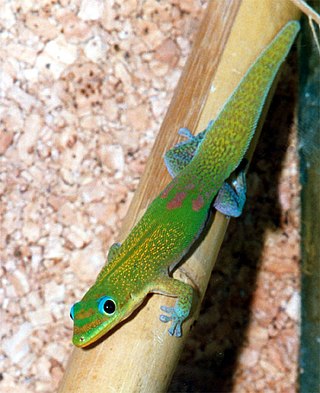
Geckos are small, mostly carnivorous lizards that have a wide distribution, found on every continent except Antarctica. Belonging to the infraorder Gekkota, geckos are found in warm climates throughout the world. They range from 1.6 to 60 centimetres.

Pseudogekko is a genus of rare gecko species, commonly known as false geckos. All 10 known species are found in the Philippines.

Gekkoninae is a diverse subfamily of the family Gekkonidae, geckos. It has the most species and genera — over 850 species in 30 genera. Hemidactylus and Cyrtodactylus together account for 185 species.

A Spanish creole, or Spanish-based creole language, is a creole language for which Spanish serves as its substantial lexifier.

Chavacano or Chabacano is a group of Spanish-based creole language varieties spoken in the Philippines. The variety spoken in Zamboanga City, located in the southern Philippine island group of Mindanao, has the highest concentration of speakers. Other currently existing varieties are found in Cavite City and Ternate, located in the Cavite province on the island of Luzon. Chavacano is the only Spanish-based creole in Asia. The 2020 Census of Population and Housing counted 106,000 households generally speaking Chavacano.
Portugis, or Ternateño, was a Portuguese-based creole language spoken by Christians of mixed Portuguese and Malay ancestry in the islands of Ambon and Ternate in the Moluccas (Indonesia), from the 16th to the middle of the 20th century.
Davaoeño (Dabawenyo) is a language of the Davao Region of Mindanao in the Philippines. According to Zorc (1977), it is a native Mansakan language influenced by Cebuano and Tagalog. Traditionally, it was the principal language of the Davaoeño people, but it is no longer spoken in Davao City as speakers have shifted to a local dialect of the Cebuano language, called Davaoeño Cebuano.

eMedia Productions is a radio and television production company based in Zamboanga City serving its base city as well as the province of Basilan and Zamboanga Sibugay.

Pseudogekko smaragdinus is a species of gecko, which is one of the many types of lizard. It is endemic to the Philippines, where it is listed by the IUCN as "least concern," presumably because populations are currently stable; this gecko is fairly common in the forests of Polillo Island, however, it is quite difficult to find in most other areas.

Pseudogekko brevipes, also known as Luzon false gecko or orange-spotted smooth-scaled gecko is a species of geckos. It is endemic to central Philippines, where it is found on several islands in dipterocarp and submontane forest at elevations of 300 to 1100 m above sea level.

Lepidodactylus labialis, also known as the Mindanao false gecko or dark-spotted smooth-scaled gecko, is a species of gecko. It is endemic to the Philippines. It is sometimes placed in the genus Pseudogekko.

Pancit choca is a Filipino black seafood noodle dish made with squid ink and bihon. It originates from Cavite, Philippines, and is originally known as pancit choca en su tinta in Caviteño Chavacano. It is also known more commonly as pancit pusit in Filipino. It is a type of pancit.
The Central Visayan false gecko is a species of gecko. It is endemic to the Philippines.
The Leyte diminutive false gecko is a species of gecko. It is endemic to the Philippines.
The Romblon Province false gecko is a species of gecko. It is endemic to the Philippines.
The southern Philippine false gecko is a species of gecko. It is endemic to the Philippines.
The Bicol false gecko is a species of gecko. It is endemic to the Philippines.
Curacha Alavar, sometimes referred to as curacha con salsa Alavar in Chavacano a Spanish-based creole language, is a Filipino dish made from spanner crabs (curacha), garlic, ginger, salt, and Alavar sauce. The key ingredient is the Alavar sauce, a secret blend of coconut milk, taba ng talangka, and various spices.

The spotted slender gecko is a species of gecko. It is endemic to Thailand.
Pseudogekko hungkag, also known as the Bicol hollow-dwelling forest gecko, is a species of gecko. It is endemic to Bicol Peninsula of Luzon, the Philippines. It is a small gecko measuring 42–52 mm (1.7–2.0 in) in snout–vent length. They have a cryptic appearance that allows them to blend into their natural habitat, crevices of hollow spaces on brown tree trunks.










